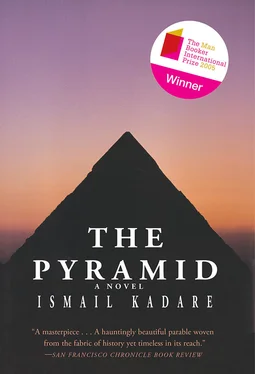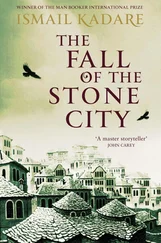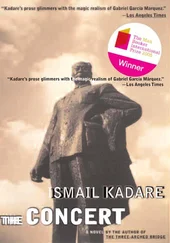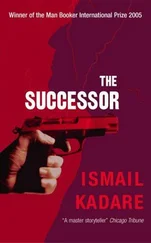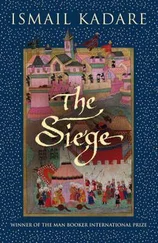And now he wanted them to abandon the gateway, to raise the chamber. To stick it in between two lumps of masonry! It would be horrible. Eventually the weight of the stone would crack such a funeral chamber like an egg, and crush the sarcophagus and the mummy with it!
The architects were at a loss. As for Rahotep, he thought he had already gone mad. And it was probably that belief that saved him, and the others too. For days and nights at a stretch he thought himself into the masonry. He strove to imagine the torture and despair of being held motionless in the dark. Sometimes he felt as if he had become aware of a new kind of distress in such irrevocable solitude. For instance, he imagined a stone shattered by the weight of surrounding masonry but, despite being in smithereens, unable to fall: it would stay where it was, unseen, its unhappy fate unknown, for all eternity.
When Imhotep came to the studio one day in a jolly mood, the other architects reckoned he really had gone mad. They were probably jealous of him, and began to hope that they too would follow him into insanity.
Rahotep had brought a number of drawings with him, The others pretended to pay attention to what he said, the way adults do with children, so as not to upset them. But suddenly in the midst of his prattle they heard him come out with something amazing. In order to reduce the weight of masonry on the funeral chamber, he said, you could construct a layered set of cavities above it, so that the pressure would bear only on the walls, and the relative distance between the funeral chamber and the vertex could be reduced by an equivalent amount.
The architects could hardly believe their ears. It was most certainly an idea of genius. Privately they blamed themselves for not having thought of it earlier. They looked on their boss with a mixture of wonderment and affection, without quite grasping what had just happened.
The next day they requested an audience with the Pharaoh. He listened to them glumly.
“Now, Majesty, you will be placed here,” said Rahotep, pointing on the model to the level where the funeral chamber would be situated.
Cheops sighed deeply, which was unusual.
“Higher!” he said in a stifled voice. “I am still too low!”
“I understand, Majesty,” replied the architect-in-chief.
“I want to be in the middle,” Cheops declared.
“I understand. Majesty.”
The whites of the Pharaoh’s eyes seemed to be wrinkled with immense weariness.
The half-suspected plot was not revealed during construction of the thirteenth or the twelfth step down, after the minister Menenre had slit his wrists. But with the eleventh, you heard people say almost everywhere, it could not fail to come to light. That is to say, if there really was a plot.
During the tenth step down some squabbling broke out between the foremen on site and the inspectors who came down from the capital to check the numbering system. The foremen maintained that they had indeed got to the tenth row down, while the visitors would not budge from the view that they were only at the twelfth, if it was not still the thirteenth. (Since counting from the base, that is to say from ground level, had been stopped by order of the new architect-in-chief and replaced by top-down numbering from the vertex, such muddles were only to be expected. How can you start counting from something that isn’t there? grumbled most of the builders. It’s like trying to cast an anchor in the clouds!)
Numbering the masonry rows in reverse, counting downward as the pyramid went up, made everyone feel somewhat uneasy, gave them a disorienting sensation of void and vertigo. People went off the wrong way, bumped into things that they had only imagined, or else failed to notice obstacles that were really there. It had all become so intolerable that most of the master builders had gone back to counting in the old way until the architect-in-chief issued a categorical orders although the final row of the pyramid had yet to be determined, henceforth all numbering must be done top down; any other way of reckoning would be taken as a sign of rebellion. A circular intended to make things crystal clear stated that the pyramid was in its present phase increasingly drawn toward the sky so that the enhancement of its heavenly progress was an imperious necessity that would already have been met had it not been hampered by outdated ideas.
“Old or new, those ideas won’t change my mind,” said the master builder Hankou. “ All it comes to is like working upside down.” But afterward he had to admit that there was nothing to be done about it, that you had to bend to this whim, that it was in the end just one more thing that was assbackward in Egypt. (“Our whole country lives like that, upside down and back to front. Only an overthrow of the regime, and of the Pharaoh too, could put things back to right.” These statements had been reported verbatim to the investigating magistrate, who waved the papyrus under his nose and yelled: “Confess! Confess that you said that! Look here, are these not your very words? Don’t you see?” “I see them,” the master builder replied, even though both his eyes had been put out in the very first week of torture.)
During the seventh step a great fear seized hold of everyone, not just those working permanently on site but all whose tasks obliged them to spend a few moments near the pyramid. “What is it?” they asked in horror. “Why, what’s going on?” they enquired of the Seveners, as they had begun to be called… “No, no, it’s nothing. I must have had a hallucination, it was probably just giddiness, I have to get back up, see you soon…”
For a while they would watch the silhouettes hopping from step to step, growing smaller in the distance before disappearing into the dust of the human anthill Those who were up there, above the rest, looking down on the mass, far from feeling more confident, shook like leaves. They would turn to look at the point where the vertex was going to be and were utterly petrified. They were right up against the sky, and each of them thought in his heart of hearts that it was probably this celestial proximity that made him feel quite weightless, convinced him of his own inanity, and inflicted him with such a burden of guilt.
Although almost nothing happened during the building of the seventh step, the masons suffered inwardly so much that as soon as it was finished (an immediate start was then made on the sixth step down) they truly believed that they had been through martyrdom. From time to time, especially during the midday break, they recounted fragments of their nightmares to each other, in good faith, as if they were talking of things that had really happened.
Crumbs from their stories (or rather, their ravings) floated down somehow or other, falling slowly from heaven like dust (or rather, antidust) and settled on the milling crowd at the base of the site.
In the evenings when they came down to return to their barracks they could feel the eyes on their backs, full of awe and admiration. The looks seemed to say: My poor friends, those are the real heroes, what hell they must be suffering up there! They were treated as if they had come straight from heaven, and people even seemed surprised that none of them had yet made use of his nearness to the sky to step over into the other world, the way a man can jump from a roof onto the balcony next door.
The curiosity surrounding the builders of step seven was but a foretaste of the even livelier interest aroused by the vertex. Now that the pyramid’s completion was imminent, everyone was obsessed by its topmost point. Some said that the hour of truth was about to strike. They feared that the pyramid was too high and that its peak would scratch or even injure the sky. “Then you’ll see what has to happen! Wretched that we are! Where can we go to hide?”
Читать дальше
